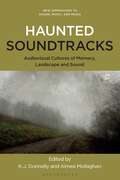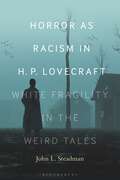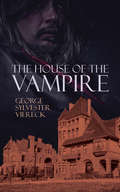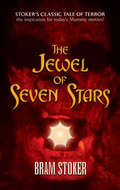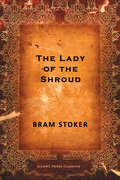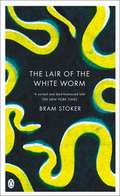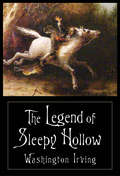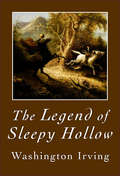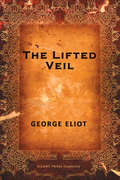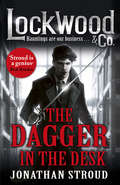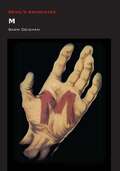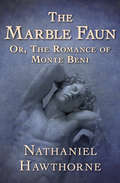- Table View
- List View
Haunted Soundtracks: Audiovisual Cultures of Memory, Landscape, and Sound (New Approaches to Sound, Music, and Media)
The turn of the millennium has heralded an outgrowth of culture that demonstrates an awareness of the ephemeral nature of history and the complexity underpinning the relationship between location and the past. This has been especially apparent in the shifting relationship between landscape, memory and sound in film, television and other media. The result is growing interest in soundtracks, as part of audiovisual culture, as well as an interest in the spectral aspects of culture more generally. This collection of essays focuses on audiovisual forms that foreground landscape, sound and memory. The scope of inquiry emphasises the ghostly qualities of a certain body of soundtracks, extending beyond merely the idea of 'scary films' or 'haunted houses.' Rather, the notion of sonic haunting is tied to ideas of trauma, anxiety or nostalgia associated with spatial and temporal dislocation in contemporary society. Touchstones for the approach are the concepts of psychogeography and hauntology, pervasive and established critical strategies that are interrogated and refined in relation to the reification of the spectral within the soundtracks under consideration here.
Horror as Racism in H. P. Lovecraft: White Fragility in the Weird Tales
by Dr. or Prof. John L. SteadmanProviding a new perspective on Lovecraft's life and work, Horror as Racism in H.P. Lovecraft focuses on the overlap between the writer's personal beliefs and the racist images and narratives in his speculative fiction. Building on recent debates about Lovecraft and drawing on the concept of "white fragility," John Steadman argues that the writer's fiction reflects his feelings of resentment and anger towards non-white persons and was used to advocate for his racist, xenophobic political beliefs – that western civilization was in decline and slavery was justifiable among "superior" civilizations. In making these claims, Lovecraft's tales pit humans against extra-terrestrial aliens, developing a terrifying, futuristic vision of the Earth as a plantation planet. The familiar image of Lovecraft as a reclusive, creative genius and mentor to young writer-friends is dismantled through close readings of his fiction and nonfiction – including correspondence, essays, and poetry – and examination of his early biography. This image is replaced by that of a cruel, callous, and, at times, psychotic man, a violently vitriolic racist and white supremacist who hated most of the non-white races. While some will dismiss the author outright and others will read his fiction but ignore the racism, Horror as Racism in H.P. Lovecraft takes a middle ground: acknowledging Lovecraft's personal history and heinous intentions, it helps readers navigate the author's disturbing biography while also getting a better sense of the stories, which remain significant within American science fiction.
The House of the Vampire
by George Sylvester Viereck"He felt the presence of the hand of Reginald Clark - unmistakably - groping in his brain as if searching for something that had still escaped him. He tried to move, to cry out, but his limbs were paralyzed. When, by a superhuman effort, he at last succeeded in shaking off the numbness that held him enchained, he awoke just in time to see a figure, that of a man, disappearing in the wall that separated Reginald's apartments from his room..."This vampire doesn't want the blood from your veins; he's after the ideas in your head. The hypnotic Reginald Clarke chooses his victims for their artistic abilities, charms them, and discards them after robbing them of their gifts. Originally published in 1907, this gothic novella was among the first stories of its type and remains a gripping tale of psychic vampirism.
I Walked With a Zombie (Devil's Advocates)
by Clive DawsonI Walked with a Zombie (1943), Val Lewton's second feature for RKO Radio Pictures, was described by critic Robin Wood as 'perhaps the most delicate poetic fantasy in the American Cinema.' Following immediately in the wake of the groundbreaking Cat People (1942), Zombie pioneered an even more radical narrative approach yet proved to be the critical and commercial equal of its predecessor, cementing the reputation of both Lewton and his director, Jacques Tourneur. Despite the lurid, studio-imposed title, I Walked with a Zombie is a subtle and ambiguous visual poem that advanced a daring condemnation of slavery and colonialism at a time when such themes were being actively suppressed by government censors. Clive Dawson charts the complex development and production of the project, essential to understanding the concerns of the filmmakers in the context of wartime Hollywood, then analyses the film in detail, referencing a broad range of academic studies of the audio-visual text and distilling new insight into its layers of meaning. Finally, he explores the film's reception, and the influence it exerted on the horror genre and beyond. Extensive primary research has uncovered a wealth of previously unpublished new material that solves many unanswered questions and dispels various myths about this utterly unique film.
IT Chapters One and Two (Devil's Advocates)
by Alissa BurgerDrawing on critical analysis of film, the horror genre, the Gothic, and Stephen King scholarship, this book considers Andy Muschietti’s IT Chapter One (2017) and IT Chapter Two (2019) on multiple levels: as film (both as individual films and through their interconnected narrative), as adaptation, and as a barometer of the horror film’s popularity among fans. Key points of consideration include the significance of the fictional town of Derry as a traditionally Gothic “bad place,” the role of 1980s nostalgia in these two films, the complex navigation of memory and trauma, gender representation, queer representation, and the return of the repressed. The terrifying figure of Pennywise the clown is central to this analysis, including consideration of performance, costuming, and significance within the larger landscape of the “scary clown” popular culture trope, and through comparison to Tim Curry’s iconic performance in Tommy Lee Wallace’s 1990 miniseries. This Devil's Advocate contextualizes Muschietti’s films within the larger landscape of King’s literary and popular culture influence, as well as the debate surrounding “elevated” horror and the “horror boom” of the late 2010s.
The Jewel of Seven Stars
by Bram StokerSomeone has seized the fabled Jewel of Seven Stars from the mummy's grip, and the ancient Egyptian queen Tera has risen from her tomb to take it back—at any cost! This thrilling tale of adventure and ritual magic recounts a supernatural struggle in which archeologists, grave robbers, and anyone else who attempts to possess the Jewel meet a mysterious, violent fate.Bram Stoker, the author of Dracula, wrote this enthralling novel of possession, reincarnation, and an ancient curse at the peak of the Victorian fascination with Egyptology. His spellbinding blend of Eastern lore and classic horror fiction formed the template for the plots of dozens of mummy movies. This edition features the original ending as it appeared in the 1903 publication, a gripping conclusion that was censored in subsequent printings and long unavailable.
The Lady of the Shroud
by Bram StokerThe Lady of the Shroud is a novel by Bram Stoker, published in 1909. The book is an epistolary novel, narrated in the first person via letters and diary extracts from various characters, but mainly Rupert. The initial sections, leading up to the reading of the uncle's will, told by other characters, suggest that Rupert is the black sheep of the family, and the conditions of having to live in the castle in the Blue Mountains for a year before he can permanently inherit the unexpectedly large million-pound estate suggest the uncle is somehow testing the heir. When an unexpected, mysterious women cloaked in a wet shroud appears, she changes Rupert's destiny forever.
The Lair of the White Worm
by Bram StokerAn ancient evil walks among them. When Adam Salton arrives at his grand-uncle's Derbyshire estate he quickly senses that a macabre and malevolent force is at work. In his attempts to uncover the grisly mystery he encounters the chilling Lady Arabella and the obsessive Edgar Caswall, each harbouring their own dark and dreadful desires. To his horror, Adam discovers that something hideous is living in the grounds of nearby Castra Regis, something that feeds on the flesh of humans. And so begins a terrifying quest to destroy the evil lurking in their midst . . .
The Legend of Sleepy Hollow
by Washington IrvingThe Legend of Sleepy Hollow, along with its companion piece, Rip Van Winkle is one of the best-known short stories to have come from America—though written while Irving was living abroad in England. Best enjoyed at Hallowe'en! The story is set in 1790 in the countryside around the Dutch settlement of Tarry Town (historical Tarrytown, New York), in a secluded glen called Sleepy Hollow. Sleepy Hollow is renowned for its ghosts and the haunting atmosphere that pervades the imaginations of its inhabitants and visitors. Some residents say this town was bewitched during the early days of the Dutch settlement. Other residents say an old Native American chief, the wizard of his tribe, held his powwows here before the country was discovered by Master Hendrick Hudson. The most infamous spectre in the Hollow is the Headless Horseman, said to be the ghost of a Hessian trooper that had his head shot off by a stray cannonball during "some nameless battle" of the American Revolutionary War, and who "rides forth to the scene of battle in nightly quest of his head".
The Legend of Sleepy Hollow
by Washington IrvingThe Legend of Sleepy Hollow, along with its companion piece, Rip Van Winkle is one of the best-known short stories to have come from America—though written while Irving was living abroad in England. Best enjoyed at Hallowe'en! The story is set in 1790 in the countryside around the Dutch settlement of Tarry Town (historical Tarrytown, New York), in a secluded glen called Sleepy Hollow. Sleepy Hollow is renowned for its ghosts and the haunting atmosphere that pervades the imaginations of its inhabitants and visitors. Some residents say this town was bewitched during the early days of the Dutch settlement. Other residents say an old Native American chief, the wizard of his tribe, held his powwows here before the country was discovered by Master Hendrick Hudson. The most infamous spectre in the Hollow is the Headless Horseman, said to be the ghost of a Hessian trooper that had his head shot off by a stray cannonball during "some nameless battle" of the American Revolutionary War, and who "rides forth to the scene of battle in nightly quest of his head".
The Lifted Veil
by George EliotQuite unlike the realistic fiction for which Eliot is best known, The Lifted Veil explores themes of extrasensory perception, the essence of physical life, possible life after death, and the power of fate. The novella is a significant part of the Victorian tradition of horror fiction.
Lockwood & Co: The Dagger in the Desk (Lockwood & Co.)
by Jonathan StroudA thrilling new case for London’s most talented psychic detection agency – from the global bestselling author of the Bartimaeus Sequence.In London, a mysterious and potentially deadly ghost is stalking the halls of St Simeon’s Academy for Talented Youngsters. It lurks in the shadows, spreading fear and icy cold – and it carries a sharp and very solid dagger . . .The headmaster wastes no time in enlisting the help of ghost-hunters Anthony Lockwood, Lucy Carlyle and George Cubbins. Can Lockwood & Co. survive the night and save the day?
M (Devil's Advocates)
by Samm DeighanFritz Lang’s first sound feature, M (1931), is one of the earliest serial killer films in cinema history and laid the foundation for future horror movies and thrillers, particularly those with a disturbed killer as protagonist. Peter Lorre’s child killer, Hans Beckert, is presented as monstrous, yet sympathetic, building on themes presented in the earlier German Expressionist horror films like The Cabinet of Dr. Caligari and The Hands of Orlac. Lang eerily foreshadowed the rising fascist horrors in German society, and transforms his cinematic Berlin into a place of urban terror and paranoia. Samm Deighan explores the way Lang uses horror and thriller tropes in M, particularly in terms of how it functions as a bridge between German Expressionism and Hollywood’s growing fixation on sympathetic killers in the ‘40s. The book also examines how Lang made use of developments within in forensic science and the criminal justice system to portray a somewhat realistic serial killer on screen for the first time, at once capturing how society in the ‘30s and ‘40s viewed such individuals and their crimes and shaping how they would be portrayed on screen in the horror films to come.
The Marble Faun: Or, The Romance of Monte Beni
by Nathaniel HawthorneFrom the author of The Scarlet Letter: The thrilling tale of three American artists whose search for artistic inspiration leads to romance and murder. The sculpture galleries and classical architecture of nineteenth-century Rome set the stage for Nathaniel Hawthorne’s gothic romance The Marble Faun. While touring the Eternal City in search of inspiration and authentic beauty, American artists Miriam, Hilda, and Kenyon soon discover that their Italian companion, Donatello—charming and in love with Miriam—bears a striking resemblance to the marble Faun of Praxiteles. But for Miriam, their carefree pursuit is also an escape from a dark past. And when a mysterious man appears, trailing the friends’ path and tormenting Miriam, the group’s travels take a sinister turn. The first novel to explore the effects of European sensibilities on American values, The Marble Faun anticipated the genre of travel novels later exemplified by The Portrait of a Lady by Henry James and The Innocents Abroad by Mark Twain. Vividly evoking the great works of art and architecture in Rome, it also found favor as an unlikely guidebook for many Victorian tourists. James Russell Lowell said: “The nineteenth century has produced no more purely original writer than Mr. Hawthorne.” Here, the author of The House of the Seven Gables offers an unforgettable and suspenseful tale. This ebook has been professionally proofread to ensure accuracy and readability on all devices.
The Masque of the Red Death (Devil's Advocates)
by Steve HabermanThe Masque of the Red Death (1964), the seventh collaboration between producer-director Roger Corman and horror icon Vincent Price, became the crowning achievement for both men, their masterpiece. After the critical and commercial success of House of Usher in 1960, Corman fervently desired to adapt Edgar Allan Poe’s story, ‘The Masque of the Red Death’ as his next project, but the tale took three years to finally become, not Corman’s second Poe film, but his second to last. Its long development benefitted the end result, and the story of its making reveals the persistence and vision of Corman, the artist and entrepreneur of classic horror. In this Devil’s Advocate, Steve Haberman takes an auteurist approach to the film with Corman as the ultimate author of the work. He explores the emergence of Corman’s themes and techniques through directorial control and compares them with the intentions and concerns of the story’s original creator, Poe. In his research, Haberman secured both drafts of the script, the first by Charles Beaumont and the last by R. Wright Campbell, consulted published interviews and met with Corman. The result illuminates not only the film but the profound and profoundly dark world views of both Roger Corman and Edgar Allan Poe.
